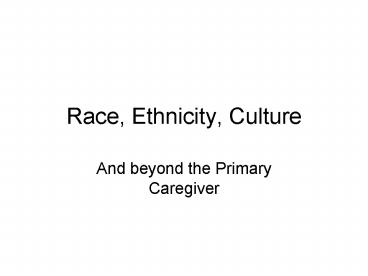Race, Ethnicity, Culture - PowerPoint PPT Presentation
1 / 26
Title:
Race, Ethnicity, Culture
Description:
Those older than 65 will increase to 20% by 2050 ... Research on Race, Ethnicity ... needs and reliance on spirituality (e.g. 'meaning based coping') vary by race. ... – PowerPoint PPT presentation
Number of Views:255
Avg rating:3.0/5.0
Title: Race, Ethnicity, Culture
1
Race, Ethnicity, Culture
- And beyond the Primary Caregiver
2
The Need to Understand Racial and Cultural
Differences in Caregiving
3
Population Changes
- Those older than 65 will increase to 20 by 2050
- Elderly White population will double 2000 2050
(X 2) - African American will quadruple (X 4)
- Hispanic increase by ( X7)
- Native Americans (X 3.5) and Pacific Islanders (X
6.5)
4
Research on Race, Ethnicity
- Relatively few studies have compared the
experience of caregiving across racial, ethnic or
cultural lines. - Mostly we know about more objective differences.
5
Problems in the research
6
Sampling
- Small, non-representative samples are the norm.
- Why is use of convenience samples a problem?
- Samples recruited through community orgs,
Alzheimers associations, social and health
service orgs., advertisements, radio, hospitals,
etc. means it is difficult to determine the
population represented by these samples. - The sample may be biased in some unknown way.
7
Some Well-Documented Differences
- Rates of institutionalization for minority elders
lower than for White elders - Prevalence of severe functional limitations
higher among minority seniors living at home than
White elders - AA and Hispanic Americans use fewer formal
services, but report need for more assistance
8
One study
- Navaie-Waliser, Feldman, Fould, Levine, Kuerbis
Donelan 2001 - Random digit dialing identified 4991 family
households in NYC - After screening, 402 individuals who met
eligibility agreed to participate. - Complete data on 397
9
Sample
- White, non Hispanic 164
- Black, non Hispanic 129
- Hispanic 87
- Other 17
- 17 overall prevalence of caregiving
10
Results
- White caregivers and care receivers were older
(71 vs. 65 for recipient). - gt70 of all cg had no help from formal
- gt80 providing care for more than 1 yr.
- Black cg more likely to be providing higher
intensity care (e.g. dressing, feeding,
transferring)
11
Black Caregivers
- Report heavier workload and more unmet needs.
- But, less likely to report difficulty providing
care - More likely to experience increased religiosity
since becoming a caregiver
12
Hispanic Caregivers
- More likely to have unmet needs than White
caregivers - More likely to receive help from paid caregivers
than White - Also, more likely to experience increased
religiosity since becoming caregiver than White
13
Overall
- Higher intensity care associated with greater
unmet needs - Caregivers providing higher intensity care were
more likely to receive formal, paid help - Increased religiosity associated with greater
unmet needs and higher intensity care
14
Overall Finding
- Caregiving workload, reported difficulty in care
provision, having unmet needs and reliance on
spirituality (e.g. meaning based coping) vary
by race.
15
Beyond Primary Caregivers
- Most research has focused on a single individual
identified as the primary caregiver but what
happens if we look at the network of family
members who provide care over time. How stable
is it and how much change occurs?
16
Longitudinal Study
- Szinovacz and Davey, 2007
- Used waves 1 through 5 (1992 -2000) of a national
survey that looked at adult children caring for
one or more parents.
17
Results
- Change in adult child caregivers occurred in 54
of cases. - gt 25 of primary adult child caregivers were
replaced by a sibling - 33 of all networks added at least one adult
child - 34.5 dropped at least one adult child.
18
Systems of Support
- Williams and Dilworth-Anderson, 2002
- 187 African American caregivers looked at use of
formal, church and informal support. - Higher education associated with use of formal
support - Greater dependency in care receiver, more
behavioral problems associated with less use of
formal services
19
- (Note did not look at effect of cognition..
Presence of dementia as a predictor as did Birkel
Canon) - Higher levels of informal support and network
density were associated with lower use of formal
services. - (Which may point to insularity)
20
Linking
- More dense networks (cohesive) did not link to
formal services. - Larger networks did link to formal services.
- Church membership did link to formal supports.
21
Networks
Low Density
22
Networks
High Density
23
Networks
Insularity
High Density
24
Networks
25
Networks
26
Networks
Linking Function































![READ⚡[PDF]✔ Raciolinguistics: How Language Shapes Our Ideas About Race PowerPoint PPT Presentation](https://s3.amazonaws.com/images.powershow.com/10049452.th0.jpg?_=20240607019)